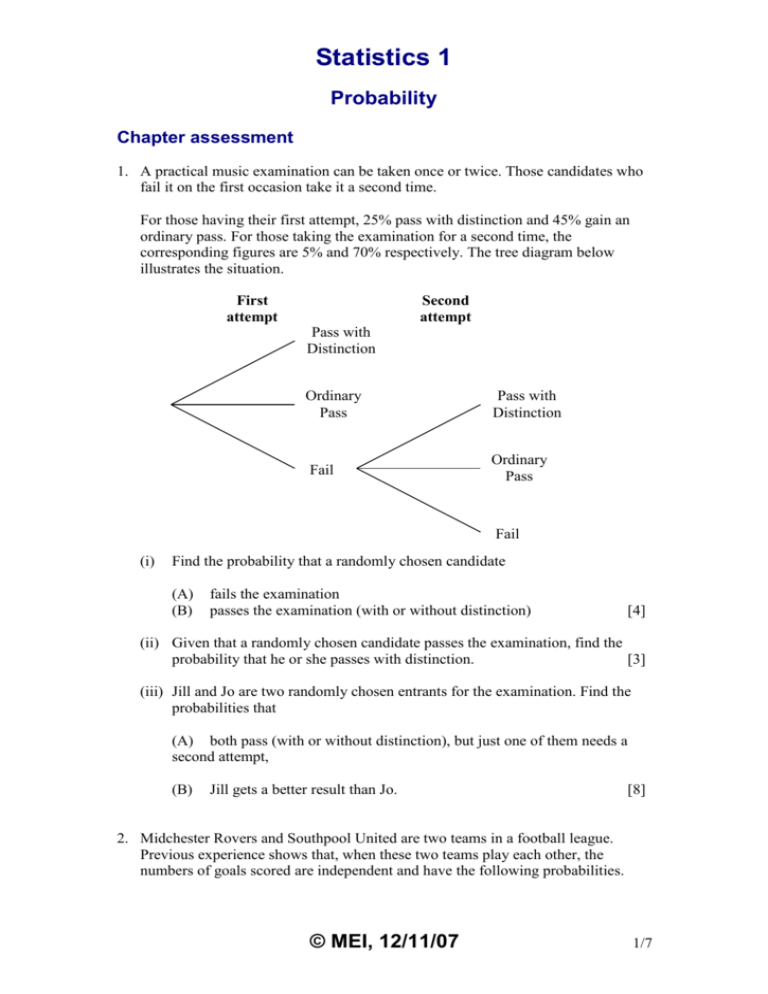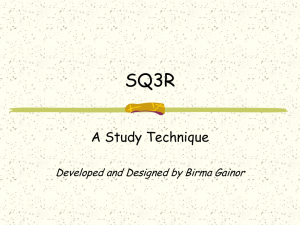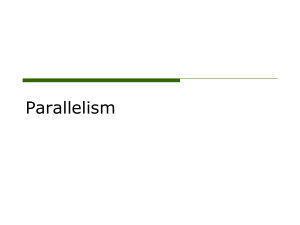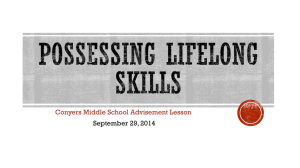Statistics Probability Chapter Assessment
advertisement

Statistics 1 Probability Chapter assessment 1. A practical music examination can be taken once or twice. Those candidates who fail it on the first occasion take it a second time. For those having their first attempt, 25% pass with distinction and 45% gain an ordinary pass. For those taking the examination for a second time, the corresponding figures are 5% and 70% respectively. The tree diagram below illustrates the situation. First attempt Second attempt Pass with Distinction Ordinary Pass Pass with Distinction Fail Ordinary Pass Fail (i) Find the probability that a randomly chosen candidate (A) (B) fails the examination passes the examination (with or without distinction) [4] (ii) Given that a randomly chosen candidate passes the examination, find the probability that he or she passes with distinction. [3] (iii) Jill and Jo are two randomly chosen entrants for the examination. Find the probabilities that (A) both pass (with or without distinction), but just one of them needs a second attempt, (B) Jill gets a better result than Jo. [8] 2. Midchester Rovers and Southpool United are two teams in a football league. Previous experience shows that, when these two teams play each other, the numbers of goals scored are independent and have the following probabilities. © MEI, 12/11/07 1/7 S1 Probability Assessment solutions Number of goals Midchester Rovers Southpool United 0 0.2 0.4 1 0.3 0.5 2 0.35 0.1 3 0.15 0 The two teams play each other. Find the probabilities of the events in parts (i) to (v). (i) (ii) (iii) (iv) (v) Midchester win the game 1 – 0. One of the teams wins the game 2 – 0. The game ends in a draw. Southpool win the game. Midchester score no goals given that Southpool win the game. [1] [2] [3] [3] [3] The probability that Southpool fail to score in k successive games against Midchester is greater than 1%. (vi) Find the greatest possible value of k. [3] 3. In the sixth form at Eastport School, there are 45 students studying at least one of the three sciences, Biology, Chemistry and Physics. The diagram below shows the number of students studying each science. Chemistry Biology 15 12 2 4 6 3 3 Physics (i) Find the probability that one of these students, selected at random, is studying (A) (B) (C) Physics Chemistry both Physics and Chemistry. (ii) Hence determine whether the events “studying Physics” and “studying Chemistry” are independent. [3] [2] (iii) Find the probability that a student, selected at random, is studying Biology, given that the student is studying Chemistry. [2] © MEI, 12/11/07 2/7 S1 Probability Assessment solutions (iv) Two students are selected at random. Find the probability that both are studying just one science and that they are not both studying the same science. [4] (v) Three students are selected at random. Find the probability that at least one of them is studying all three sciences. [3] 4. A survey is conducted to find which type of property people live in and whether the property is owned or rented by its occupier. The results for a particular region of the country are as follows. Type of property Detached / semi-detached Terraced house Flat / bedsit Proportion of each type 45% 35% 20% Proportion of properties Owned Rented 75% 25% 50% 50% 35% 65% A property is chosen at random. (i) Construct a tree diagram to represent the information in the table. [3] (ii) Find the probability that the property is owned. [3] (iii) Find the probability that the property is a terraced house or is rented. [3] (iv) Given that the property is owned, calculate the probability that it is a terraced house. [3] Two properties are now chosen at random. (v) Find the probability that they are of different types. [3] Total 60 marks © MEI, 12/11/07 3/7 S1 Probability Assessment solutions Solutions to Chapter assessment 1. First attempt 0.25 0.45 Second attempt Pass with Distinction Ordinary Pass 0.05 0.3 0.7 Fail Pass with Distinction Ordinary Pass 0.25 Fail (vi) (A) P(FF) 0.3 0.25 0.075 (B) P(passes) 1 0.075 0.925 (vii) Let A be the event that the candidate passes Let B be the event that the candidate passes with distinction. P( A B ) 0.25 (0.3 0.05 ) 0.25 0.015 0.265 P(A) = 0.925 (from part (i)) P( A B ) 0.265 P(B | A ) 0.286 (3 s.f.) P( A ) 0.925 (viii) (A) P(passing on first attempt) = 0.7 P(passing on second attempt) 0.3 0.75 0.225 P(Jill passes on first attempt and Jo passes on second attempt) 0.7 0.225 0.1575 P(Jill passes on second attempt and Jo passes on first attempt) 0.7 0.225 0.1575 P(both pass but just one needs a second attempt) 0.1575 0.1575 0.315 (B) P(passes with distinction) = 0.265 (from (ii)) © MEI, 12/11/07 4/7 S1 Probability Assessment solutions P(passes with ordinary pass) = 0.925 – 0.265 = 0.66 P(fails) = 0.075 P(Jo fails and Jill passes) 0.075 0.925 0.069375 P(Jo gets an ordinary pass and Jill passes with distinction) 0.66 0.265 0.1749 P(Jill gets a better result than Jo) 0.069375 0.1749 0.244 (3 s.f.) 2. (i) P(Midchester score 1 goal and Southpool score 0) 0.3 0.4 0.12 (ii) P(Midchester score 2 goals and Southpool score 0) 0.35 0.4 0.14 P(Midchester score 0 goals and Southpool score 2) 0.2 0.1 0.02 P(one team wins 2 – 0) 0.14 0.02 0.16 (iii) P(score is 0-0) 0.2 0.4 0.08 P(score is 1-1) 0.3 0.5 0.15 P(score is 2-2) 0.35 0.1 0.035 P(score is 3-3) 0.15 0 0 P(score is a draw) 0.08 0.15 0.035 0.265 (iv) P(score is 0-1) 0.2 0.5 0.1 P(score is 0-2) 0.2 0.1 0.02 P(score is 1-2) 0.3 0.1 0.03 P(Southpool win) 0.1 0.02 0.03 0.15 (v) Let A be the event that Midchester score no goals Let B be the event that Southpool win the game P( A B ) 0.1 0.02 0.12 P(B ) 0.15 (from part (iv)) P( A B ) 0.12 P( A |B ) 0.8 P(B ) 0.15 (vi) P(Southpool fail to score in k successive games) 0.4k 0.4k 0.01 0.45 0.01024 0.46 0.004096 so the largest possible value of k is 5. © MEI, 12/11/07 This can also be done using logarithms if C2 has been covered. 5/7 S1 Probability Assessment solutions 3. (i) (A) Total number of studying Physics = 4+3+6+3 = 16 16 P(Physics) 45 (B) Total number studying Chemistry = 15+2+4+6 = 27 27 3 P(Chemistry) 45 5 (C) Total number studying both Physics and Chemistry = 4+6 = 10 10 2 P(Physics and Chemistry) 45 9 (ii) (iii) 16 3 16 P(P C ) 45 5 75 so the events are not independent. P(P ) P(C ) 19 45 P(B C ) 19 3 19 5 19 P(B |C ) P(C ) 45 5 45 3 27 P(B C ) 3 2 6 45 44 1980 3 12 36 P(P, B) = P(B, P) 45 44 1980 2 12 24 P(C, B) = P(B, C) 45 44 2980 6 36 24 66 1 Probability 2 1980 990 15 (ix) P(P, C) = P(C, P) 41 45 41 40 39 P(all three students are not studying all three) 45 44 43 41 40 39 P(at least one is studying all three) 1 45 44 43 0.249 (3 s.f.) (x) P(a student is not studying all three sciences) © MEI, 12/11/07 6/7 S1 Probability Assessment solutions 4. (i) 0.45 0.35 0.2 Detached / semi Terraced house Flat / bedsit 0.75 Owned 0.25 0.5 Rented Owned 0.5 0.35 Rented Owned 0.65 Rented (ii) P(owned) (0.45 0.75 ) (0.35 0.5 ) (0.2 0.35 ) 0.5825 (iii) P(terraced house or rented) (0.45 0.25 ) 0.35 (0.2 0.65 ) 0.5925 (iv) Let A be the event that the property is owned Let B be the event that it is a terraced house. P( A B ) 0.35 0.5 0.175 P( A B ) 0.175 P(B | A ) 0.300 (3 s.f.) P( A ) 0.5825 (v) Probability that they are of the same type 0.45 2 0.35 2 0.2 2 Probability that they are of different types 1 (0.45 2 0.35 2 0.2 2 ) 0.635 © MEI, 12/11/07 7/7






